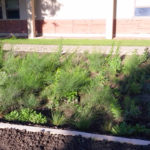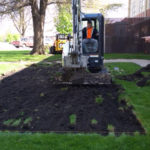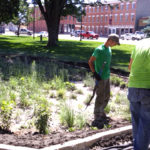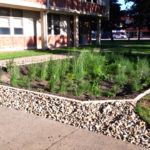Clarke County Courtyard Rain Garden Provides Unique Opportunities & Education
With the booming 4th of July festivities on the horizon, Osceola residents are invited to view and show off to visitors the only Courtyard in Iowa to have a Rain Garden.
While on a Clarke County Prairie Nature Walk three years ago Sue Wilder, Marilyn Dorland and Brad Riphagen came up with the idea of creating a rain garden in Osceola. The garden was born out of a desire to showcase good land stewardship in the city while also exhibiting plants, wildflowers and grasses native to Iowa.
Click through the images below to see the installation of the Clarke County Courtyard Rain Garden:
Brad assisted Sue and Marilyn in securing a grant through Trees Forever and helped them research and plan the perfect mixture of plants. When the original location for the rain garden fell through, the Board of Supervisors was approached about relocating to the west lawn of the courthouse. Many volunteers pitched in to dig the plot to the correct depth and to perform necessary drainage testing before the garden could be officially started. With the donated time and resources of courthouse employees, Jan Rychnovsky and Master Gardeners, Osceola Water Works, the Board of Supervisors, and Trees Forever, Sue and Marilyn were able to fulfill their water conservation project and finally installed the garden in the fall of 2015. Since then, the garden has flourished to make a beautiful and functional addition to the Osceola Square.
“A rain garden uses water run-off to support a variety of perennial flowers and native vegetation,” explained Sue Wilder. “By redirecting half of the water from the roof of the courthouse, it helps recycle the water runoff from the roof as well as create a beautiful space that improves water and soil quality using very little resources.”
Anyone can plant their own rain garden to contribute to water and soil conservation efforts. Generally located near streets, sidewalks and roof downspouts, rain gardens utilize run-off that would otherwise flow into storm drains. The run-off from roofs and streets that would normally require more chemical treatment are instead filtered naturally through the soil. Native plants will spread their roots deeper in the soil, six feet or more, which will in turn help restore soil quality over time by building high organic matter, as well as allowing the plants to draw water from deep underground in times of drought.
A variety of plants that grow naturally in Southern Iowa were planted by many volunteers. The garden includes Little Bluestem, June Grass, prairie drop seed, Sky Blue Aster, Cream Indigo, Butterflyweed, Prairie Phlox, Golden Alexander – often mistaken for dangerous wild parsnip but harmless itself, Prairie Blazing Star, Showy Goldenrod, Prairie Smoke, and Lead Plant. This one-of-a-kind garden is made up of a range of plants from ground crawlers to tall backdrop plants and are known to attract songbirds, butterflies and dragonflies among other species. A beautiful list of the Iowa-indigenous plants found in the garden can be seen on a beautiful metal sign manufactured and donated by Perry Welding for the location.





